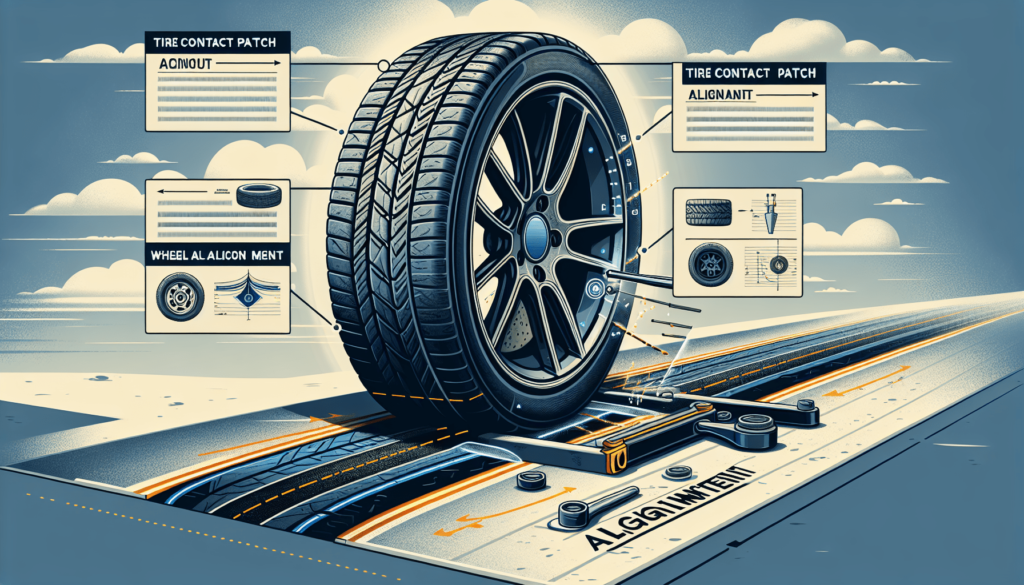Have you ever wondered how wheel alignment can impact the contact patch of your tires? It may seem like a small detail, but the alignment of your wheels can have a big impact on your vehicle’s performance and safety. When your wheels are properly aligned, the contact patch, which is the area of the tire that actually touches the road, is optimized. This allows for better traction, improved handling, and even tire wear. On the other hand, if your wheels are misaligned, it can lead to an uneven contact patch, resulting in reduced stability and increased tire wear. So, let’s dive into the fascinating world of wheel alignment and explore its impact on the all-important tire contact patch.

Definition of Wheel Alignment
Understanding the concept of wheel alignment
Wheel alignment refers to the adjustment of the angles of the wheels so that they are parallel to each other and perpendicular to the ground. It involves adjusting the angles of camber, castor, and toe-in/toe-out, which are crucial for maintaining optimal tire performance and ensuring safe and efficient driving.
Different types of wheel alignment
There are three main types of wheel alignment: front-end alignment, thrust alignment, and four-wheel alignment. Front-end alignment, also known as two-wheel alignment, focuses on aligning the front wheels. Thrust alignment involves aligning the rear wheels with the front wheels to ensure a straight driving motion. Four-wheel alignment, as the name suggests, aligns all four wheels for maximum precision and balance.
Tire Contact Patch
Definition and significance of tire contact patch
The tire contact patch refers to the area of the tire that comes into direct contact with the road surface. It plays a critical role in providing traction, stability, and control while driving. The size and shape of the contact patch determine the tire’s ability to grip the road, distribute the vehicle’s weight evenly, and handle various road conditions.
Factors influencing the size and shape of the contact patch
Several factors influence the size and shape of the tire contact patch. These include the tire’s inflation pressure, load carrying capacity, tread design, and road surface conditions. Proper wheel alignment also significantly impacts the contact patch, as it ensures that the tires are aligned in a way that optimizes their performance and maximizes the contact area with the road.
Impact of Wheel Alignment on Tire Contact Patch
Effects of misalignment on the contact patch
Misalignment of the wheels can have several negative effects on the tire contact patch. When the wheels are not properly aligned, the contact patch may not be evenly distributed across the tire’s surface. This can lead to uneven wear patterns, reduced traction, and compromised handling capabilities. It can also lead to increased resistance, resulting in reduced fuel efficiency and a shorter tire lifespan.
Uneven tire wear due to misalignment
One of the most common effects of wheel misalignment on the contact patch is uneven tire wear. Misalignment causes certain areas of the tire to experience excessive wear while other areas remain relatively untouched. This can result in a shortened tire lifespan and the need for premature replacement. Additionally, uneven tire wear can lead to a rough and uncomfortable ride and compromise the overall safety of the vehicle.
Redistribution of tire load with misalignment
Misalignment can also lead to an uneven redistribution of the vehicle’s weight on the tires. When the wheels are not properly aligned, some tires may bear a higher load than others. This uneven distribution of weight can increase tire stress and wear, negatively impacting the contact patch’s performance. It can also result in compromised handling and stability, reducing the overall control of the vehicle.
Positive Wheel Alignment Effects on Contact Patch
Improved traction and handling
Proper wheel alignment ensures that the tires maintain optimal contact with the road surface, resulting in improved traction and handling. When all four wheels are aligned correctly, the tire contact patch is maximized, allowing for better grip and control, especially during cornering and braking. This can enhance the overall stability and safety of the vehicle, providing a smoother and more enjoyable driving experience.
Even tire wear patterns
Correct wheel alignment promotes even tire wear patterns, ensuring that the tires wear evenly across their entire surface. This not only extends the tire’s lifespan but also enhances the vehicle’s overall performance and fuel efficiency. Even wear patterns also contribute to a quieter and smoother ride, minimizing the need for frequent tire replacements and reducing maintenance costs in the long run.
Enhanced fuel efficiency and tire lifespan
Proper wheel alignment reduces rolling resistance and improves the tire’s efficiency in transferring power from the engine to the road. This, in turn, enhances fuel efficiency and reduces fuel consumption, saving you money at the pump. Additionally, when the tires wear evenly due to proper alignment, their lifespan is extended, reducing the frequency of tire replacements and saving you money in the long term.

Negative Wheel Alignment Effects on Contact Patch
Reduced traction and handling
Wheel misalignment leads to a reduced contact area between the tire and the road surface, resulting in decreased traction and compromised handling. This can be particularly dangerous during wet or slippery conditions, where the tires’ ability to grip the road is crucial for maintaining control of the vehicle. Reduced traction can also result in longer braking distances and an increased risk of skidding or hydroplaning.
Uneven and rapid tire wear
Misalignment causes uneven wear patterns on the tires, resulting in rapid and uneven tire wear. Some areas of the tire may experience excessive wear, while other areas remain relatively untouched. This not only shortens the tire’s lifespan but also compromises its structural integrity, making it more prone to punctures or blowouts. Uneven tire wear can also lead to a rough and uncomfortable ride, negatively affecting the overall driving experience.
Increased fuel consumption and tire replacement frequency
Misalignment can increase rolling resistance, requiring more energy to move the vehicle forward. This leads to increased fuel consumption and reduced fuel efficiency. With misaligned wheels, the tires may also wear out more quickly, requiring more frequent replacements. This can add up to significant costs over time, both in terms of fuel expenses and tire replacements.
Types of Wheel Alignment Adjustments
Camber adjustment and its impact on the contact patch
Camber adjustment refers to the measurement of the tire’s tilt inward or outward from the vertical axis when viewed from the front or rear of the vehicle. Positive camber is when the top of the tire leans outward, while negative camber is when the top of the tire leans inward. Proper camber alignment ensures that the tire’s contact patch is maximized, providing better stability, cornering ability, and even tire wear.
Toe adjustment and its influence on the contact patch
Toe adjustment refers to the measurement of the angle between the tires when viewed from above. Toe-in is when the fronts of the tires are closer together than the rears, while toe-out is when the fronts of the tires are farther apart than the rears. Correct toe alignment ensures that the tires roll parallel to each other, minimizing scrubbing and improving the contact patch’s performance.
Caster adjustment and its effect on the contact patch
Caster adjustment refers to the measurement of the angle between the steering axis and a vertical line when viewed from the side of the vehicle. It affects the vehicle’s straight-line stability and steering effort. Proper caster alignment ensures that the contact patch is aligned with the direction of travel, resulting in improved stability, comfortable steering, and reduced tire wear.

Common Signs of Misalignment
Uneven tire wear
One of the most noticeable signs of wheel misalignment is uneven tire wear. You may observe that certain areas of the tire have significantly more or less tread than others. If you notice this uneven wear pattern, it is essential to have your wheels aligned to prevent further damage to the tires and ensure optimum performance.
Vehicle pulling to one side
Another common sign of wheel misalignment is when your vehicle constantly pulls to one side while driving on a straight road. This occurs when the wheels are not properly aligned, and one tire experiences more resistance than the other. If you need to exert extra effort to keep the vehicle straight, it’s time to get your wheels aligned.
Steering wheel vibration
If you feel a slight vibration or shaking in the steering wheel while driving, it could be an indication of wheel misalignment. Misaligned wheels can cause the vehicle to vibrate, and this vibration is felt through the steering wheel. Ignoring this issue can lead to further damage and compromise the safety of your vehicle.
Off-center steering wheel position
A steering wheel that is not centered while driving straight is another noticeable sign of wheel misalignment. If you find yourself constantly adjusting the steering wheel to keep the vehicle straight, it is essential to have your wheels aligned. An off-center steering wheel position can be both a visual and physical reminder that your vehicle’s alignment needs attention.
Unusual tire noises
Wheel misalignment can cause tires to produce unusual noises while driving. These noises can include squealing, humming, or thumping sounds. If you hear any unfamiliar noises coming from your tires, it is advisable to have your wheels checked for misalignment, as this could be a sign of excessive tire wear or other alignment-related issues.
Importance of Regular Wheel Alignment
Optimal tire performance and longevity
Regular wheel alignment is crucial for optimizing tire performance and increasing their lifespan. Proper alignment ensures that the tires wear evenly, minimizing the chances of premature wear and tear. By maintaining optimal alignment, you can maximize the mileage you get from your tires and avoid the need for frequent replacements.
Improved safety and driving comfort
Wheel alignment directly affects the vehicle’s stability, traction, and handling, all of which are essential for safe and comfortable driving. Properly aligned wheels provide better control and responsiveness, especially in emergency situations. By maintaining regular alignment, you can ensure safer driving experiences and a more comfortable ride for you and your passengers.
Prevention of suspension and steering system damage
Misaligned wheels can exert additional stress on the suspension and steering components of your vehicle. Over time, this can lead to accelerated wear and potential damage to these essential systems. Regular alignment checks and adjustments can prevent unnecessary strain on these components, helping to maintain their longevity and reducing the risk of costly repairs.
Cost-effectiveness in the long run
While regular wheel alignment may seem like an additional expense, it can save you money in the long run. Properly aligned wheels promote even tire wear, extending the lifespan of your tires and reducing the frequency of replacements. Furthermore, optimized fuel efficiency resulting from correct alignment can save you money on fuel expenses. Ultimately, investing in regular alignment checks and adjustments can prove to be cost-effective and save you from unnecessary expenses down the road.

Measurement and Adjustment Process
Wheel alignment inspection
The wheel alignment process begins with a thorough inspection of the vehicle’s suspension and steering components. This includes checking for any signs of damage or wear that may affect the alignment. The technician will also examine the tires for uneven wear patterns and evaluate the overall condition of the vehicle’s suspension system.
Alignment angles measurement
After the initial inspection, the technician will use specialized tools and equipment to measure the alignment angles of the wheels accurately. This involves measuring the camber, toe, and caster angles to determine the current alignment status of each wheel. These measurements serve as a baseline for determining the necessary adjustments.
Alignment adjustments: procedures and tools
Based on the measurements, the technician will proceed to make the necessary adjustments to align the wheels properly. This is done using specialized tools and equipment to adjust the suspension and steering components. The adjustments will vary depending on the specific alignment angles that need correction, such as camber, toe, or caster. The technician will ensure that all adjustments are made according to the manufacturer’s specifications for your specific vehicle.
Post-adjustment verification
Once the alignment adjustments are complete, it is crucial to verify the accuracy of the alignment. The technician will re-measure the alignment angles to ensure that they match the desired specifications. This step is essential to ensure that the adjustments were made correctly and that the wheels are now properly aligned. Verification also provides peace of mind that your vehicle is safe to drive.
Conclusion
The critical interrelation between wheel alignment and tire contact patch
Wheel alignment and the tire contact patch have a crucial interrelation, as the alignment directly affects the size, shape, and performance of the contact patch. Proper alignment ensures that the tires make optimal contact with the road surface, resulting in improved traction, handling, and tire wear.
Understanding the importance of regular alignment checks and adjustments
Regular wheel alignment checks and adjustments are essential for maintaining optimal tire performance, maximizing their lifespan, and ensuring safe and comfortable driving. By addressing any misalignment issues promptly, you can prevent uneven tire wear, reduce fuel consumption, and avoid costly repairs.
In conclusion, proper wheel alignment is vital for optimizing the tire contact patch, ensuring even tire wear, enhancing traction and handling, and improving fuel efficiency. Regular alignment checks and adjustments contribute to safer and more comfortable driving experiences, prolong the lifespan of your tires, and save you money in the long run. Don’t underestimate the impact of wheel alignment on your vehicle’s performance and prioritize regular maintenance to reap the benefits.


